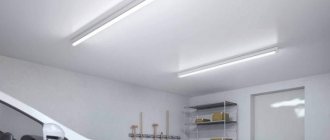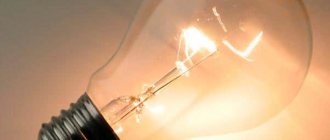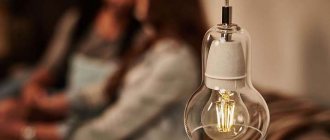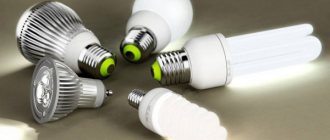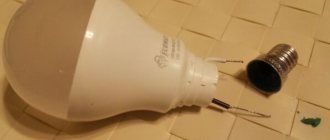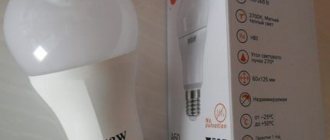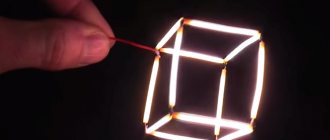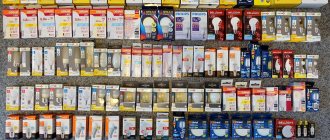Natural lighting does not make it possible to create adequate conditions for underwater inhabitants. It illuminates the tank unevenly. In winter, the length of the day is noticeably reduced. In this regard, it is impossible to do without the use of artificial lighting. Therefore, below we will tell you how to make LED lighting for an aquarium with your own hands using inexpensive and accessible materials.
LED lighting is used to implement decorative functions and create an optimal habitat for plants and organisms. The importance of LED lamps is due to the following reasons:
- Possibility of creating effective lighting intensity.
- High quality LED lamps.
- Long period of exposure to lighting.
Main features of LED lamps
The advantages of this light source are as follows:
- Low energy consumption. Despite the high operating power, the lamps in the aquarium work efficiently.
- The lamp body does not heat up during operation. There is no need to worry about having an additional source of cooling in the aquarium.
- Effective illumination of every corner of the aquarium thanks to the presence of a directed light flux.
- Availability of various color combinations. You can easily install lighting of the required spectrum in the aquarium.
- Maintaining high quality work, even after time. The light spectrum remains unchanged.
- Long service period. The average service life is 30,000–60,000 hours.
Thanks to the long period of operation, you will not often have to wonder about replacing the ice lighting source. Moreover, arrays consisting of several light bulbs can be used. There are no disadvantages to this aquarium device. The only thing I would like to note is that it has recently appeared on the modern market, so this device is not widely distributed.
Manufacturers rating
The following models of diode devices are fully adapted to aquarium plant growing conditions. It is better to pay attention to them when choosing a lamp, and not to cheap Chinese products, the characteristics of which do not always correspond to the declared ones.
- AQUAEL is a manufacturer from Poland, whose models are characterized by ease of use and low energy consumption. A constant supply of light is provided by spare diodes in the housing, which are switched on when the main ones fail. The AQUAEL lamp is inexpensive, despite its purely European quality.
- ISTA is a Taiwanese manufacturer that has long been producing not only lamps for aquariums, but also other products. The product range is quite wide and includes models with improved color rendering, lines with blue and white diodes, as well as full-spectrum products and devices for small tanks. The manufacturer has developed a unique color rendering of 7000K, which has a beneficial effect on photosynthesis processes.
- Chihiros are Chinese products characterized by high quality. They are distinguished by their affordable cost, uniform distribution of light flux, provision of powerful and rich colors and the ability to effectively emphasize contrasts. You can control the devices not only manually, but also remotely through a special application.
- ADA AQUASKY 602 – Japanese LED lamps, highly specialized for growing aquarium plants. The ideal distribution of luminous flux, coupled with the intensity of illumination, best represents natural conditions. The cost of devices of this brand is high, but it is fully justified by their perfection.
- Kessil - devices that allow you to adjust the light intensity and spectrum depending on the stage of vegetation growth. It has 4 types of light, which are selected based on the age of the plants.
You can also choose an LED model for an aquarium and other European, American or Asian manufacturers. The main thing is to be confident in the quality of the products presented and the good reputation of the manufacturer.
Choosing LED lamps for your aquarium wisely
The selection of light bulbs for an aquarium should be based on two key parameters. The first is the intensity of the light flux. The second is color temperature. When choosing a lamp, pay attention to the lumen/W indicator. The higher it is, the greater the energy efficiency, that is, the efficiency of the light source. Also pay attention to the pulsation coefficient of the light flux - let it be less than 5%, ideally 1%. Higher values of this indicator will lead to increased eye fatigue, and why do you need an aquarium that negatively affects your health.
Each aquarium light has a different color temperature range. In an aquarium it should not be less than 5500 K. The ideal solution is if the color temperature is 6000–8000 K.
If an ice light source with a value of less than 4000K or lower is selected, the light will be excessively yellow. Conversely, a value of more than 6000K indicates a predominance of blue color. The most favorable color palette for an aquarium is warm white, cool white or daylight.
The quality level of the light source is no less important. You should not buy overly cheap lamps. They have an increased glow intensity only during the first time of use. After a certain period of time, the process of degradation of the light source can be observed, which negatively affects the inhabitants of the flora and fauna of an artificial home pond. The choice of lamp shade is an individual decision of the tank owner.
How the lighting works
Proper lighting is important for underwater plants, not for fish, shellfish, shrimp and other marine life. After all, a lack of light leads to a slowdown in photosynthesis processes, which has a detrimental effect on the health of the aquarium flora.
The light itself is a set of rays of different shades - from red to violet:
- Red rays are not able to penetrate to depth, illuminating only surface vegetation.
- Blue rays reach the very bottom, to deep plants.
- Red color along with orange increase the formation of carbohydrates during photosynthesis and are absorbed by chlorophyll.
- Blue and violet rays inhibit the growth of certain parts of plants. Therefore, with this exposure, they become compact, with thick leaves capable of completely absorbing light.
For normal photosynthesis and full development of vegetation in the aquarium, full spectral lighting is necessary.
For the full development of vegetation in the aquarium, full spectral lighting is necessary.
What is the best way to install LED lamps?
You can easily install LED lamps in an aquarium with your own hands. During this work, in order to achieve the most comfortable microclimate in the tank and an attractive visual effect, it is important to do this work correctly. When mounting lamps on top, a cover glass should be provided to help prevent excessive evaporation of liquid, fish jumping out, or water droplets falling onto the bulbs. To save electrical energy, we recommend installing a timer that will automatically turn off the lights according to a given pattern.
The main thing is to light the aquarium in such a way that all the needs of living beings and plants are satisfied. If you notice, for example, that the algae are not as bright as before, and the fish have turned pale, then there is a high probability that the backlight is installed poorly. Rotting of plant roots indicates that the LEDs are not directed towards their roots.
It should be noted that the abundance of light is also a mistake in setting the correct amount of lighting. In such a situation, the water blooms and there is a green coating on the walls.
Backlight options
Aquarium lighting and lighting should not be confused. The first is used as a complement to the second. But these are also decorative elements. A tank with strange plants and beautiful fish leading a leisurely and measured life can serve as a decoration for any apartment. Psychologists have also proven that seeing creatures floating in the water calms the nervous system and has a beneficial effect on vision. Therefore, equipping an aquarium with LEDs, in addition to everything, serves a decorative function, therefore, it is important to pay attention to the design.
The easiest way is to install an LED lamp. This is suitable for small containers within 50 liters. Typically, the lids of such aquariums already have E27 and E14 sockets designed for conventional tungsten incandescent lamps. All that remains is to choose an LED light bulb with sufficient power.
Another option is LED floodlights. The photo shows an example of use. This direction is suitable for open aquariums. Such lamps easily illuminate the water column to the bottom of a tank of any depth. For a small aquarium, one spotlight is sufficient. It is recommended to install up to three depending on the size and volume of the water tank.
Using LED spotlights for illumination
There are also ready-made panels with LEDs. The disadvantage is the high price; it is not always possible to make such a useful, but not very economical purchase. At the same time, the desire to have a beautiful aquarium, equipped with everything necessary according to the latest fashion trends, remains. Where can I find a compromise? Don't give up and despair. Let us remember the well-known saying: “It is not the gods who burn the pots.” An LED aquarium lamp will make this dream come true.
How to make light in an aquarium is up to you. Lighting stores and websites have a large assortment of different colors. Aquarium lighting can be made in either a warm or cold shade. Usually they prefer the latter due to the fact that it passes through the water better. If the aquarium is not very deep, then this will not play a big role. Then the choice can be made based on the situation in the apartment.
During installation, it is necessary to take into account that for the natural growth and development of the plant world, the direction of light flows must be oriented from top to bottom. This is evidenced by many years of practice and advice from experienced aquarists.
How to light an aquarium
There are two simple ways to organize lighting. The first method is the simplest. DIY LED lighting for an aquarium will help significantly reduce your costs. You will need an LED strip.
Next, you simply carefully stick it around the perimeter of the structure. Please note that lighting an aquarium with LED strip will make the lighting as uniform as possible, although it will not be energy efficient enough. This tape is sold in a skein. On one side of the tape there are LEDs, and on the other there is double-sided tape. But you should keep in mind that this type of lighting is not the only source for your aquarium. To create complete lighting, it is advisable to use additional T5 or T8 LED lamps. The place where the tape and cord are fixed must have insulation based on silicone filler.
The second lighting method is the installation of LED lamps. It is more popular and allows you to create complete and high-quality lighting of the entire tank. It is not difficult to assemble an LED lamp for an aquarium with your own hands. The lamp consists of a certain number of lamps. How many of them should you take? For a container of 200–300 liters you will need 40 spot lamps. Each bulb must be rated at 270 lumens (3 watts each).
Types of LED lamps for aquariums
Ice lighting devices for aquariums are presented in three types:
- lamps;
- ribbons;
- spotlights.
The LED module can be purchased at a specialized store or made by yourself. You immediately need to decide on the features of the device, depending on some factors:
- where it will be located - in the water or outside the container, depending on which it is necessary to select the protection class;
- whether it will be automatic or not - the presence of a timer and controller will make caring for your home pond as simple as possible;
- whether natural phenomena and other special effects will be present in the composition.
LED lighting that is selected for an aquarium must, in any case, have an appropriate class of protection against water and short circuits.
Lamps
LED lamps are most suitable for small aquariums. They perfectly illuminate 50-60L tanks, being an effective and inexpensive option. It is very convenient to use diode lamps in the lid of a container, where sockets for incandescent lamps of the corresponding connector are prepared in advance. In any case, even an inexperienced person in electrical engineering can install the lamps.
The lamps perfectly illuminate 50-60L tanks, being an effective and inexpensive option
Spotlights
A fairly expensive lighting option that is waterproof and can function even after a short immersion in water. The spotlights are attached to the lids of the aquarium or to the walls, the thickness of which is at least 2 cm. They are suitable for large containers, because one spotlight with a power of 50 watts can illuminate a 100-liter volume.
Suitable for large containers, because one spotlight with a power of 50 watts can illuminate a 100-liter volume
Ribbons
They have high strength, resistance to vibration and external mechanical influences. Four types of LED strip are used for aquariums - SMD 3528, 5050, 5630, 5730. The first are suitable for tanks with a volume of no more than 30 liters, the second - up to 100 liters. These types of tapes are used for large aquariums, but require additional cooling.
The tapes have high strength, resistance to vibration and external mechanical influences
DIY tank lighting with LED lamps
If you first study useful information, installing aquarium lamps will not cause difficulties. Installation of lamps involves the sequential implementation of the following stages:
- Preparation of necessary materials for work. We will need 6-7 LED lamps (3 W, 270 lm, 6000 K) with cold light and about 3-4 pieces oriented towards warm light (3000 K). Based on individual wishes, you can take others.
You should also prepare a gutter or panel made of plastic with parameters of 200 cm by 100 cm. You cannot do without a 12 W power supply and wires (2 mm). The number of 3 W lamps must be selected taking into account the volume of the aquarium. One piece is equivalent to 12–16 liters of tank. For example, if you have a 200 liter aquarium, then you will need about 30 3 W lamps to create good conditions for the inhabitants. For drilling you will need a 48 mm cutter and connector sockets (GU5.3; MR16; MR11) about 10 pieces (for the number of lamps). A fan will be needed if necessary. - It is necessary to insert our lamps into a plastic panel or trough. The length and width of the gutter are selected taking into account the parameters of the aquarium for lamps with LEDs. There are approximately 10 holes per 100 cm. The holes are made using a milling cutter. The lamps are connected to the installed connectors.
- Connecting LED lamps.
It is produced in parallel with the existing power source. For example, you can use a power supply from a personal computer. Only the necessary outputs of the power supply connector are connected. Below is a diagram. - We install a lamp and a fan. For cooling, you can use any computer fan.
Advantages and disadvantages of LEDs
LED lights have only recently begun to be used for lighting aquariums, but quickly gained unprecedented popularity. And all thanks to their functional characteristics:
- efficiency - optimal energy consumption with a high level of brightness and good power;
- resistance to various types of impacts and vibrations due to the absence of thin spirals in the design, high strength;
- durability - the service life of such lamps reaches up to 5 years;
- beneficial effects of the spectral range on aquarium inhabitants;
- fire safety due to short circuit protection and tolerance to constant humidity;
- the absence of unnecessary heat, which allows you to maintain the correct thermal regime;
- environmental friendliness due to the lack of infrared and ultraviolet radiation and toxic substances in the design itself.
The only disadvantages of this type of lamp are their high price and the need to purchase a power supply.
Summing up - LED lamps for an aquarium - how profitable are they?
From the information described above, we can conclude that installing LED lamps for an aquarium does not cause additional difficulties. Having previously read the literature on this issue, you can easily install them in a tank using a self-created lamp. Do-it-yourself LED aquarium lighting organized in this way has a large number of advantages. It creates high-quality and complete lighting for underwater inhabitants, is economical, and has a varied combination of colors. The only disadvantage of using lamps is their relatively high cost. However, over time, these products easily pay for themselves. The aquarium operates in energy-saving mode.
Light in the aquarium
To ensure that beginners in the aquarium business do not make unforgivable mistakes, remember that inside the aquarium there is a real biological environment in which life develops, and the laws of this development are in your hands, as the creator of this world. Lighting allows not only fish, but also plants to develop properly, but its amount should not be insufficient or, conversely, excessive. All this leads to unpleasant consequences.
Professional aquarists still argue about the power and spectrum of lighting, which indicates the rather high complexity of the issue. Therefore, in order for beginners to avoid the most common mistakes, we will try to analyze the most important information in this article. The rest you can only learn from your own experience.
Result of improper lighting
Let's start by naming the main problems that arise when the lighting conditions are incorrect.
Such an environment may be unfavorable for aquarium fish, and there is no beauty to be seen here
- Too bright and prolonged lighting causes abundant growth of algae, which leads to rapid contamination of the tank - the water begins to bloom.
- The light cycle of plants should be close to natural, that is, about 10-12 hours. However, some specifically increase the luminosity period to stimulate faster growth of aquarium flora. We do not recommend overdoing it, as too long, even, or short periods of lighting disrupt the natural biorhythms of plants, causing them stress. For this reason, plants often begin to get sick.
- Certain types of aquarium plants require long and bright light for normal growth. The catch here is that such a regime can harm the fauna, that is, the fish. As a result, many fish, accustomed to living in shaded areas in natural conditions, begin to fade, losing the brightness of their color. They hide from the bright light among algae and stones, instead of swimming and pleasing the eye of the observer.
This aquarium seems uninhabited
- Another problem is associated with aquariums whose height exceeds the standard 38 centimeters. The fact is that due to the height, very little light reaches the bottom of the aquarium, so ground plants begin to suffer. The mistake beginners make is that they increase the lighting levels to support their development.
- As a result, the fish become inactive and try to find a secluded corner where they can hide from the annoying light. Soon the water begins to bloom, and in such conditions, pathogenic bacteria very often begin to develop, which can greatly harm the fauna.
This concerns an overabundance of lighting. And what happens to plants when there is not enough light:
- The fact is that light (its power) is the main parameter on which the development of flora completely depends. If you try to compensate for the lack of lighting with fertilizers and carbon dioxide, then be prepared for a fiasco.
- The consumption of CO2 by plants directly depends on the intensity of total daylight, and no fertilizer can affect this.
- The reason is simple - the reaction of photosynthesis cannot occur without the energy that plants obtain from light. As a result of this reaction, they begin to convert CO2, minerals and water into organic tissue. Remember your school biology course - unlike us and animals, plants are autotrophic organisms!
- If light does not reach the plants, then carbon dioxide and all kinds of fertilizers remain unclaimed. The result of such a light regime can already be imagined without being a biologist. Plants will slow down in development or simply die.
- As soon as we increase the brightness, we immediately see rapid development, lush plants and vibrant greenery. The oxygen bubbles that cover the leaves will immediately become noticeable.
Bubbling of plants in an aquarium is a sign of photosynthesis occurring.
This process means saturating the water in the aquarium with oxygen, which is required by fish and other underwater inhabitants. If you observe a similar phenomenon in your aquarium, it means you did everything right. The rules of nature are unchanged - photosynthesis requires three elements: light, water and mineral inorganic substances, also known as fertilizers.
Common Mistakes
We have already said that increasing the length of daylight hours for an aquarium can have negative consequences, in the form of rampant development of algae and rapid clogging of the water in the aquarium.
- An attempt to use light sources with peaks of blue or red light as aquarium lamps leads to similar results. As a result, threads, beards and other troubles develop in the aquarium.
- It is quite difficult to control such pests, so it is better to prevent their appearance at all.
- You can come across a lot of advice on the Internet talking about the benefits of the blue and red spectrum, saying that in normal lighting they are not enough for normal plant growth. The answer, we think, suggests itself. Since they grow with the natural spectrum in nature, they should also grow with it in the aquarium.
- Contrary to these myths, plants do not consume only these spectra. In fact, absorption occurs more or less evenly across the entire visible light spectrum, that is, the use of lamps with extreme spectra is unfounded and can only harm flora, not to mention fauna.
Advice! If we talk about light temperature, then the optimal lamps for plants are 6500-8000 Kelvin, which we will discuss in more detail later.
However, the use of lamps of extreme spectra is possible, but only in combination with other colors, that is, the organization of mixed lighting.
How to choose LEDs
If lighting is needed only for fish, there are no special rules, but live underwater plants require a certain amount of light and a sufficient number of lamps.
The number of diodes is calculated based on the number of lumens - units of measurement of light flux, whereas in fluorescent lamps such as T8 or T5 it is measured by power expressed in Watts.
Unpretentious aquarium plants need 30-40 lumens per liter of water, but particularly selective plants require 40-60 lumens. For such inhabitants, a color temperature of more than 5500 Kelvin is preferable. You can install cold or warm white LEDs with minimal addition of red and blue; plants do not need green light. All characteristics, as a rule, are indicated on the light sources themselves or in the documents for them, so choosing the right number and power of LEDs is not difficult.
Mode, calculation of aquarium lighting
When setting up an aquarium, special importance is attached to lighting. The thing is that the health of the inhabitants of the aquarium, as well as their color, depends on its quality. Lighting also affects the general condition of underwater plants. That is why this issue should be taken with full responsibility.
On average, it is recommended to light an aquarium for at least twelve hours a day. Among aquarists, this period is called a tropical day. In order for plants and fish to develop evenly, lighting is placed in the upper part of the aquarium above the water, mainly on the lid.
It is worth noting that many plants that live in water move their leaves to the central part of the rosette at night. They can also close growth points. As a rule, this happens closer to nine o'clock in the evening. Thus, plants demonstrate that photosynthesis, which is carried out with the help of light, is over. This sets the lighting mode for the aquarium.
The absence of bright night lighting is essential for plants. The thing is that at this time of day they are engaged in the assimilation and processing of carbon accumulated during daytime photosynthesis
Therefore, it is very important for plants to observe the alternation of day and night.
Fish are also sensitive to the change of day: it has a significant impact on the behavior of pets. In the dark, fish that were too active during the day rest, they swim slowly and even freeze for several hours. Those fish that naturally become active as night falls begin to show signs of life.
For example, there is a type of catfish that does not leave their shelters during the day even if they are very hungry. Therefore, if such fish live in an aquarium, it is necessary to add food for them before turning off the lights.
The calculation of aquarium lighting is made depending on what types of plants and fish live in it. Some experts believe that to achieve the desired level of lighting, it is enough to install the aquarium so that it receives natural light.
It is worth noting that exposure to sunlight causes water to overheat, algae begin to grow much faster, and the water may even “bloom.” First of all, fish suffer from this. That is why the right solution would be to use special aquarium lamps. In order not to have to constantly switch lamps when you need to switch from day mode to night mode and vice versa, you can use special timers.
Why is LED lighting better?
Due to the huge diversity of living creatures and greenery in a reservoir, it is necessary to “adjust” and sometimes use not one, but several different light sources to preserve all species, with the help of which you can extend the length of the day.
Some aquarists use LED spotlights, while others prefer conventional lamps. Still others use halogens or good fluorescent lamps, while others choose LED strips in the aquarium.
In theory, a normal light source:
- It must emit rays in many spectral ranges at once, so that all plants (both lower and higher) grow and do not bloom. If you use, for example, ordinary lamps that have only a yellow spectrum, then higher plants may wither, and because of this, the water will quickly bloom.
- Do not heat the water. A lamp installed in close proximity to any home water area warms it up, at least a little. Many fish cannot tolerate an increase in the temperature of the surrounding fluid by more than 2°C and may die.
Let's consider all the options and find out which lamps are more profitable to use:
- Halogens are a good and economical source of luminous flux. They provide excellent light and do not emit much heat. But they are more expensive than regular ones.
- A simple light bulb is a popular type of lighting for a mini-reservoir. But it only produces yellow light, which is unacceptable for higher plants. Such a lamp has a high heat output, and if it is located close to the aquarium, living creatures can die due to incorrect temperature conditions. To eliminate heat, you can use ice by throwing it into water in cellophane bags.
- Luminescent samples were the most popular among aquarists. They are economical, durable, have a wide spectrum and diffused light. Just a pair of such lamps can fully illuminate a 400 liter pond. The spectrum produced depends on the gas inside them. But they are dangerous due to the presence of mercury vapor in the cylinder.
- LED lights for a planted aquarium are the best option. Their low heat transfer and high efficiency are known to everyone. They are environmentally friendly and harmless to any inhabitant of the home depths. Their range is limitless.
- LED strip is a little worse than the previous option. Sometimes you have to search for a long time for a suitable assortment. Many tapes have low light output, and if bright ones are not available, you have to increase their quantity.
Light characteristics
Aquarium plants develop well in different lighting conditions. Some of them need bright light, while some need low light. That is, the choice of lamps depends on what will grow in the aquarium.
Lighting power standards in fluorescent lamp watts:
- 0.1 – 0.2 W/l – used in containers without living plants.
- 0.2 - 0.4 W/l - installed in aquariums with catfish and other nocturnal fish. With such power, the following plants will grow well: Vallisneria, cryptocorynes, mosses.
- 0.4 – 0.5 W/l – used in jars with unpretentious higher plants. At the same time, the greenery grows slowly and stretches upward towards the light.
- 0.5 – 0.8 W/l – with this light you can make a beautiful aquarium. The plants will grow well and their leaves will be brightly colored.
- 0.8 - 1 W/l - such powerful lamps are used only in densely planted herbal gardens with ground cover plants. Such aquariums are called aquascapes, Amanovsky or Dutch.
Recently, with the advent of new technologies in the production of lamps, the illumination in an aquarium is usually calculated in lumens. Standards in watts are outdated. After all, incandescent, fluorescent, LED and halogen lamps with the same electrical power of 50 watts shine with different intensities.
Lighting power standards in lumens:
- Low lighting – up to 30 lm/l.
- Moderate lighting – 30-50 lm/l.
- Preferred illumination is 50-70 lm/l.
- High illumination – 70-100 lm/l.
- 100 lm/l and above - very high illumination.
